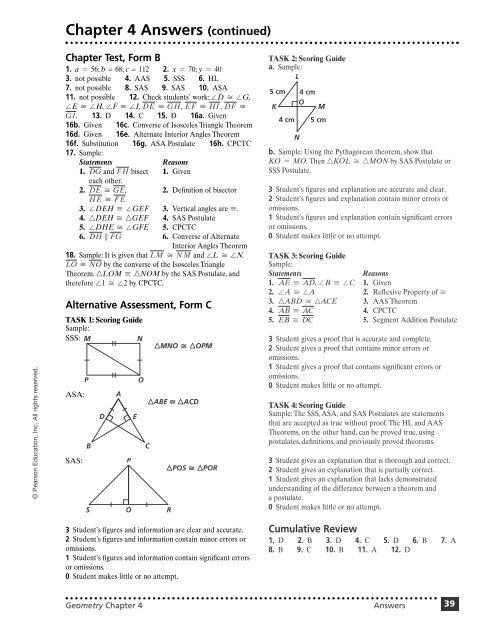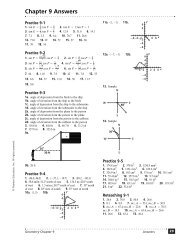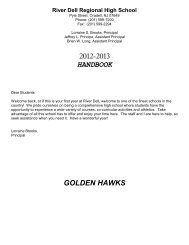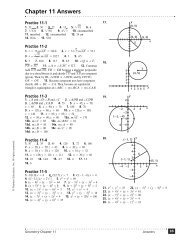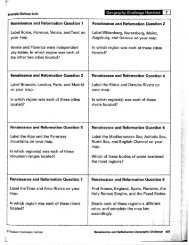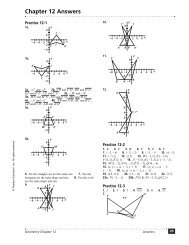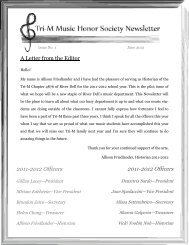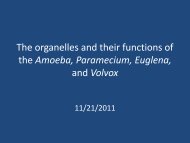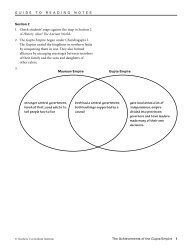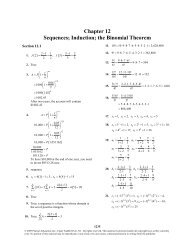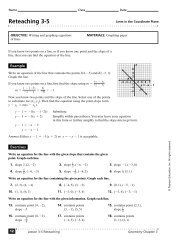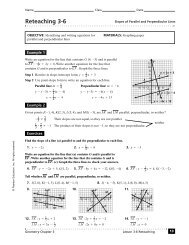chp 4 worksheet answers
chp 4 worksheet answers
chp 4 worksheet answers
You also want an ePaper? Increase the reach of your titles
YUMPU automatically turns print PDFs into web optimized ePapers that Google loves.
Chapter 4 Answers (continued)<br />
© Pearson Education, Inc. All rights reserved.<br />
Chapter Test, Form B<br />
1. a = 56; b = 68; c = 112 2. x = 70; y = 40<br />
3. not possible 4. AAS 5. SSS 6. HL<br />
7. not possible 8. SAS 9. SAS 10. ASA<br />
11. not possible 12. Check students’ work; D G,<br />
E H, F I, DE GH, EF HI , DF <br />
GI. 13. D 14. C 15. D 16a. Given<br />
16b. Given 16c. Converse of Isosceles Triangle Theorem<br />
16d. Given 16e. Alternate Interior Angles Theorem<br />
16f. Substitution 16g. ASA Postulate 16h. CPCTC<br />
17. Sample:<br />
Statements<br />
Reasons<br />
1. DG and FH bisect 1. Given<br />
each other.<br />
2. DE GE, 2. Definition of bisector<br />
HE FE<br />
3. DEH GEF 3. Vertical angles are .<br />
4. DEH GEF 4. SAS Postulate<br />
5. DHE GFE 5. CPCTC<br />
6. DH 6 FG<br />
6. Converse of Alternate<br />
Interior Angles Theorem<br />
18. Sample: It is given that LM NM and L N.<br />
LO NO by the converse of the Isosceles Triangle<br />
Theorem. LOM NOM by the SAS Postulate, and<br />
therefore 1 2 by CPCTC.<br />
Alternative Assessment, Form C<br />
TASK 1: Scoring Guide<br />
Sample:<br />
SSS: M<br />
N<br />
ASA:<br />
SAS:<br />
P<br />
B<br />
S<br />
D<br />
A<br />
P<br />
O<br />
E<br />
O<br />
C<br />
kMNO OkOPM<br />
kABE OkACD<br />
kPOS O kPOR<br />
3 Student’s figures and information are clear and accurate.<br />
2 Student’s figures and information contain minor errors or<br />
omissions.<br />
1 Student’s figures and information contain significant errors<br />
or omissions.<br />
0 Student makes little or no attempt.<br />
R<br />
TASK 2: Scoring Guide<br />
a. Sample:<br />
L<br />
5 cm<br />
K<br />
4 cm<br />
4 cm<br />
O<br />
M<br />
N<br />
5 cm<br />
b. Sample: Using the Pythagorean theorem, show that<br />
KO = MO. Then KOL MON by SAS Postulate or<br />
SSS Postulate.<br />
3 Student’s figures and explanation are accurate and clear.<br />
2 Student’s figures and explanation contain minor errors or<br />
omissions.<br />
1 Student’s figures and explanation contain significant errors<br />
or omissions.<br />
0 Student makes little or no attempt.<br />
TASK 3: Scoring Guide<br />
Sample:<br />
Statements<br />
Reasons<br />
1. AE AD, B C 1. Given<br />
2. A A 2. Reflexive Property of <br />
3. ABD ACE 3. AAS Theorem<br />
4. AB AC<br />
4. CPCTC<br />
5. EB DC<br />
5. Segment Addition Postulate<br />
3 Student gives a proof that is accurate and complete.<br />
2 Student gives a proof that contains minor errors or<br />
omissions.<br />
1 Student gives a proof that contains significant errors or<br />
omissions.<br />
0 Student makes little or no attempt.<br />
TASK 4: Scoring Guide<br />
Sample: The SSS, ASA, and SAS Postulates are statements<br />
that are accepted as true without proof. The HL and AAS<br />
Theorems, on the other hand, can be proved true, using<br />
postulates, definitions, and previously proved theorems.<br />
3 Student gives an explanation that is thorough and correct.<br />
2 Student gives an explanation that is partially correct.<br />
1 Student gives an explanation that lacks demonstrated<br />
understanding of the difference between a theorem and<br />
a postulate.<br />
0 Student makes little or no attempt.<br />
Cumulative Review<br />
1. D 2. B 3. D 4. C 5. D 6. B 7. A<br />
8. B 9. C 10. B 11. A 12. D<br />
Geometry Chapter 4 Answers 39


